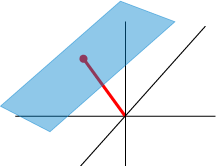Section1.3Week 2 (May 28-Jun 1)
This week, you'll wrap up the initial material from Chapter 1 by honing your computational and conceptual skills by discovering and learning to interpret the pivots in an augmented-matrix form of a linear system of equations. This is also the week to begin in earnest the work on your proof portfolio (Section 4) that will continue throughout the semester.
To do this week:
- By Wednesday 5/30: Pose some questions about mathematics by recording a short video here: https://flipgrid.com/b2fa61
- By Wednesday 5/30: Submit Quiz 1R on Blackboard
- By Wednesday 5/30: Read and annotate the following.
- 1.3 Computation with Sage (no annotation needed): http://merganser.math.gvsu.edu/david/linear.algebra/ula/ula/sec-sage-introduction.html
- 1.4 Pivots and their influence on solution spaces: https://via.hypothes.is/http://merganser.math.gvsu.edu/david/linear.algebra/ula/ula/sec-pivots.html
- NB: When annotating, be sure you have selected the "Linear Algebra" group and not "Public," or I won't be able to see your annotations!
- Around Wednesday 5/30: Discuss your proof portfolio questions on Piazza at http://piazza.com/bridgew/summer2018/math202.
- NB: On your proof portfolio, especially remember that (1) quality beats quantity -- you can earn mastery with as few as 3 good proofs; and (2) you'll have the opportunity to revise your work based on feedback, so get as far along as you can but don't worry if it's not perfect yet!
- By Saturday 6/2: Submit Quiz 2 on Blackboard
- By Saturday 6/2: Upload rtifact(s) for Learning Standards 1.A and 1.B into your Portfolio 1 on Blackboard. (Think: what have I completed for this course so far that shows evidence I can do what's listed in 1.A and 1.B in the syllabus? This could be a copy of a quiz, or a set of WeBWoRK exercises carefully worked out, or something else if you can make the case. You'll be adding more on Monday when you submit.)
- Work on WeBWoRK exercises (see Blackboard) to prepare for Quiz 2. Post and respond to your classmates' questions on Piazza at http://piazza.com/bridgew/summer2018/math202.
Q: What should I be doing in my proof portfolio this week?
This week, review the Portfolio 1 problems in Section 4 and identify 3-5 that you want to work on writing up. Then
- Open a new blank document on Overleaf and begin working on your writeups.
- Drop into the Piazza discussion board to participate in conversations about the proofs. If you want to share your writeup with others in this forum, you can copy-paste the Read-Only Link for your document found in Overleaf's SHARE menu.
- Aim to have a first draft of your writeups ready by Friday (6/1). You'll submit a PDF copy of this writeup as part of Portfolio 1 on Monday (6/4).
Subsection1.3.1The Parametric Form of a Solution Set
Finding the solution set of a linear system and expressing your answer in parametric form will be a crucial part of our skill set for the entire course. The brief video above illustrates the process.
Subsection1.3.2None, One, or Infinite: Interpreting RREF
Developing a geometric intuition for what linear systems of equations describe can be very helpful in keeping your feet on the ground in linear algebra. The first two key intuitions are
- The number of variables determines the dimension of the space in which our solutions reside.
- The number of equations determines the number of hyperplanes whose intersection gives the solution set.
Immersive Math has a terrific set of tools on this page to help visualize a variety of solution types for \(3\times 3\) systems in particular: http://immersivemath.com/ila/ch05_gausselim/ch05.html.
The crucial idea here --- which will motivate a lot of the general theory in the next chapter --- is that of independence. Each pivot in a linear system of equations marks both a:
- Basic variable whose value the system will have power to determine, and a
- Independent equation which tells a story that the other equations cannot tell alone.
In other words, pivots are the way that a linear system marks "which variables are bound" and "which equations actually matter" in its solution set. For this reason, finding and quantifying the pivots in a linear system will be our primary tool for resolving important questions of independence in linear algebra.
